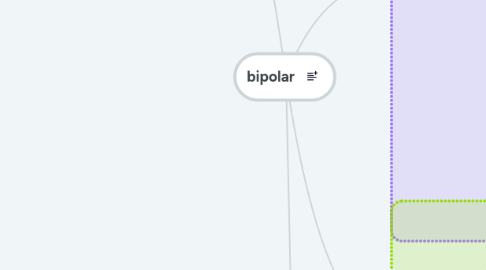
1. explanations
1.1. genetic/neurohem
1.1.1. disorders can be passed on
1.1.2. 42 clinical bipolar grp
1.1.2.1. 16 ppt had 1deg relative w affect disorder
1.1.3. 40 age/sex matched normal grp
1.1.4. DNA test- polymorphism
1.1.4.1. serotonin receptor 2c
1.1.4.2. serotonin transporter genes
1.1.4.3. alteration link to depresssive episode
1.1.5. result- no sig association. serotonin sexually dimorphic in female
1.1.5.1. risk of bp ^ in women
1.2. cognitive-beck
1.2.1. neg views form reality
1.2.2. cog distortion
1.2.2.1. due to early life experi
1.2.2.2. develp neg schemas
1.2.3. cog triad
1.2.3.1. neg views abt themseleves
1.2.3.1.1. thinks they are unworthy
1.2.3.2. neg views abt world
1.2.3.2.1. world is against them
1.2.3.3. neg view abt the future
1.2.3.3.1. anticipate failure
1.3. learned helplessness
1.3.1. perceive unpleasantness is inescapable
1.3.2. attribution style
1.3.2.1. how ind explain cause of behaviour
1.3.2.2. prev life exp lead to diff attrib style
1.3.3. link btwn attrib/depression
1.3.3.1. BDI given to find severity
1.3.3.1.1. dep/bipolar grp
1.3.3.1.2. control
1.3.3.2. attribu style questionnaire (ASQ)
1.3.3.2.1. 12 hypo gud/bad situation
1.3.3.2.2. causal attribu fr each
1.3.3.2.3. rate cause on 7 point scale
1.3.3.3. bi/uni ^ neg atti style than control
2. treatment
2.1. biomed
2.1.1. MAOI
2.1.1.1. monoamine oxidase inhibitors
2.1.1.1.1. stops monoamine oxidase enzyme from breaking
2.1.1.1.2. maintains these at ^ lvl
2.1.1.2. side effect
2.1.1.2.1. headache
2.1.1.2.2. insomnia
2.1.1.2.3. addiction
2.1.1.2.4. withdrawl probs/ issue w other meds
2.1.2. both drugs ^ eff than placebos
2.1.3. SSRIs
2.1.3.1. selective serotonin reuptake inhibitors
2.1.3.1.1. stop sero from reaborb/broken down
2.1.3.1.2. common med
2.2. ECT
2.2.1. electricity applied uni/bilaterally to brain to induce seizures
2.2.1.1. treatment resistant
2.2.2. 1000 uni/bipolar ppt
2.2.2.1. ect gave 50 % remission rate
2.2.2.2. short session > high relapse
2.3. cog restructuring
2.3.1. 1-1 talking therapy
2.3.2. explain how cog triad works- way of thinking = depression
2.3.3. practice outside therapy
2.3.3.1. thoughts challenged
2.3.3.1.1. explore if acc reflection of reality
2.3.3.2. reattributing
2.3.3.2.1. find cause of prob
2.3.3.2.2. reframe thinking
2.4. REBT
2.4.1. based on stoicism
2.4.1.1. perception of events matter
2.4.2. ABC model
2.4.2.1. activating event
2.4.2.1.1. fail interview
2.4.2.2. belief
2.4.2.2.1. ill never get anywhere
2.4.2.3. consequence
2.4.2.3.1. feeling sad
2.4.3. need to change belief about a event
2.4.3.1. irrational = depression
2.4.3.2. maintain construtive rational pattern
2.4.4. disputing
2.4.4.1. question irrational belief
2.4.4.1.1. reformulate them to healthy ones
3. symptoms
3.1. Depression
3.1.1. sadness//hopelessness
3.1.2. loss of interest in enjoyable acts
3.1.3. struggle to concentrate
3.1.4. fatiuge
3.1.5. hard to make decisions
3.1.6. change in sleep/appeitie
3.1.7. consider/attempt suicide
3.2. mania
3.2.1. long period of high
3.2.2. rage/irratability
3.2.3. easily distracted/racing thoughts
3.2.4. sudden interest in new acts
3.2.5. overconfidence
3.2.6. no sleep
4. BDI
4.1. 21 item self report
4.1.1. measures severity of depression
4.2. 4 statements - choose most app
4.2.1. feeling in past 2 wk
4.3. scores for each
4.3.1. total added
4.3.1.1. <10 min depress
4.3.1.2. 19- 29 mod depress
4.3.1.3. 30 > severe
4.4. BDI-2 -update
4.4.1. same struc
4.4.1.1. inc appetitie & fatigue
